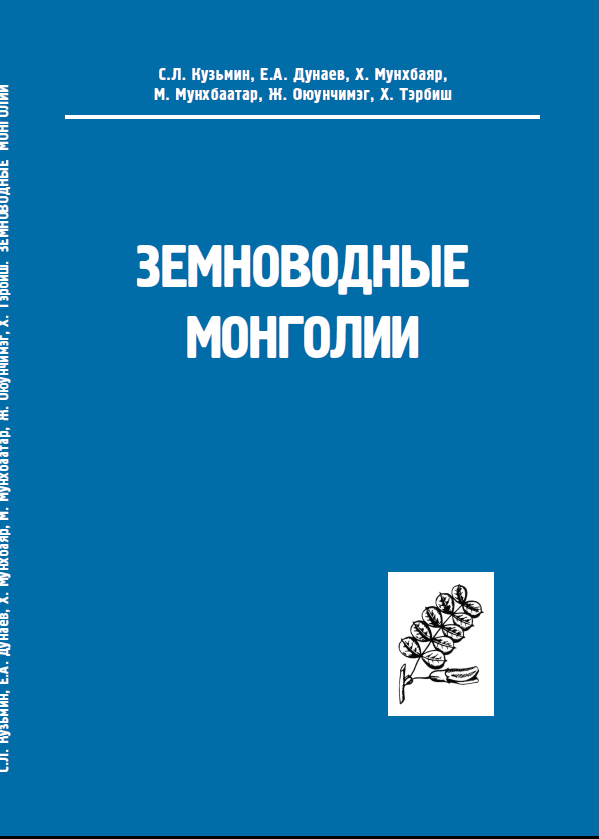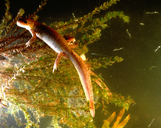|
Description
Skin smooth. Lungs present. Vomerine teeth in V-shaped series. Parotoids
well-developed. Costal grooves well-developed. Tail compressed laterally.
Toes 4, sometimes 2-5 as an anomaly. No claws in larvae or adults. Larvae of
limnophilous type which do not overwinter. Tail slightly shorter, equal or
slightly longer than body with head. Coloration brown, bronze-brown, olive or
greyish with light, often golden or silver longitudinal dorsal band and dark
spots. Males have relatively longer and higher tails than females, a larger
cloaca (both in length and width), relatively longer forelegs and a total
length equal to fore- and hindlegs. These differences are more pronounced
during the reproductive period.
Distribution and Habitat
Country distribution from AmphibiaWeb's database: China, Japan, Korea, Democratic People's Republic of, Mongolia, Russian Federation
The Siberian Newt possesses the widest geographical range of any recent
amphibian species, ca. 12 million square km. It lives in Russia, the north of
Kazakhstan, Mongolia, China, Korea and Japan. The northern margin of the range
extends from the Russian Plain (Arkhangelsk Province) eastwards to the Arctic part
of the Urals (Tyumen Province, south of Yamal Peninsula) through the south of
Taimyr Peninsula, Krasnoyarsk Region (Avam River) to the north of Yakutia
Republic and Chukotka Peninsula. The southern margin of the range runs from the
north-east of Kostroma Province through Kirov and Perm Provinces of Russia
to the southern Urals and Northern Kazakhstan near Omsk Province (Russia), then
through the south of Siberia, Northern and Central Mongolia, Heilonjiang and
Girin Provinces of China and North Korea. The species inhabits wet conifer,
mixed, deciduous forests in the taiga zone and riparian groves in tundra and
forest steppe. At the margins of its range, the existence of populations
depends on the presence of permanent stagnant pools in the valleys of rivers.
Life History, Abundance, Activity, and Special Behaviors
Salamandrella keyserlingii is a unique amphibian in its freeze-tolerance:
adults are able to survive freezing to -35 - -40oC and can move at +0.5
- +1.0oC. The spawn can survive short-term freezing in the ice. Adults can
survive in a frozen state for a very long time. Sometimes frozen salamanders,
found in the permafrost at a depth of 4-14 m, "revive" after melting. About
ten such instances are known from Siberia. Hibernation starts in
September-October and ends in most places from April to the beginning of May.
The total duration of overwintering is not less than ca. 45% of the year. It
increases northwards to about 75% of year. The newt hibernates in rotten trees,
under logs, snags, in holes, etc., usually in groups. Reproduction starts in
mid-April - May (temperate zone), or at the end of May - mid-June (in Arctic
and Subarctic zones). In mountains the phenology is more complex and depends on
the local microclimate. In general, only 4-10% of the annual activity falls
within the aquatic phase which tends to increase in duration northwards. The
clutch is a pair of egg sacs connected to one another by a short mucous stalk
which serves to attach the clutch to the substrate. Each sac contains 14-166
eggs (usually 50-90 eggs). Fertilization seems to be external but deserves
further studies. Hatching occurs after 15-40 days in the temperate zone and
after 12-24 days in the Subarctic zone. Just after hatching, the larva is 8-10
mm in total length. The larvae eat benthic and phytophilous invertebrates, and
only a small percentage of plankton. Food of aquatic adults is similar to that
in larvae, but consits of larger prey sizes. Terrestrial adults eat mainly
slugs and arthropods. The main enemies of eggs and larvae are aquatic insects, while
vertebrates are the main predators of adults.
Trends and Threats
The species is most numerous in the taiga; population sizes may reach a few
thousand animals. The abundance seems to decrease gradually southwards and
northwards, attaining the lowest level in the tundra and steppe zones.
Populations of the Siberian Newt are in relatively safe condition on the major
part of its wide range. Peripheral populations, which are usually highly
isolated, are more vulnerable. This especially concerns the populations living
in the extremal conditions of the tundra, forest steppe and steppe.
Records of the subfossil remains of Salamandrella cf. keyserlingii in the
south of the European part of the former Soviet Union, extending far beyond the recent
distribution of the species, provide evidence for the species' decline and
range constriction. Drying of wetlands, destruction of terrestrial habitats,
industrial chemical pollution of environment, etc., are known as factors
negatively influencing the newt populations. Deforestation and aridization of
landscape may have slower but more global negative consequences.
Relation to Humans
The species is common in many agricultural areas of Siberia. It lives also in
many cities (e.g., Eketerinburg, Novosibirsk, Tomsk, etc.), but it is usually
not numerous there, and cannot be considered as a species well-adapted to
urban conditions.
Comments
Populations from southeastern Siberia (Primorye Region) are genetically distinct and have recently been recognized as a distinct species, Salamandrella schrenckii. However, Kuzmin (2008) demonstrated that this name is invalid and assigned another name, S. keyserlingii tridactyla. Currently the author recognizes it as a subspecies but it may be elevated to species rank in the future, if results from Poyarkov and Kuzmin (2008) are confirmed.
 Read more about the Siberian Newt from Mongolia in The Amphibians of Mongolia by Kuzman 2017 (PDF) Read more about the Siberian Newt from Mongolia in The Amphibians of Mongolia by Kuzman 2017 (PDF)
References
Anufriev, V. M. and Bobretsov, A. B. (1996). Fauna Evropeiskogo Severo-Vostoka Rossii 4. Amfibii i Reptilii [Fauna of the European North-East of Russia]. Nauka, St. Petersburg.
Bannikov, A. G., Darevsky, I. S. and Rustamov, A. K. (1971). Zemnovodnye i Presmykayushchienya SSSR [Amphibians and Reptiles of the USSR]. Izdatelistvo Misl, Moscow.
Bannikov, A. G., Darevsky, I. S., Ishchenko, V. G., Rustamov, A. K., and Szczerbak, N. N. (1977). Opredelitel Zemnovodnykh i Presmykayushchikhsya Fauny SSSR [Guide to Amphibians and Reptiles of the USSR Fauna]. Prosveshchenie, Moscow.
Kuzmin, S. L. (1995). Die Amphibien Russlands und angrenzender Gebiete. Westarp Wissenschaften, Magdeburg.
Kuzmin, S. L. (1999). The Amphibians of the Former Soviet Union. Pensoft, Sofia-Moscow.
Nikolsky, A. M (1936). Fauna of Russia and Adjacent Countries: Amphibians (English translation of Nikolsky, 1918, Faune de la Russie et des Pays limitrophes. Amphibiens. Académie Russe des Sciences, Petrograd, USSR). Israel Program for Scientific Translations, Jerusalem.
Nikolsky, A. M. (1906). Herpetologia Rossica. Mémoires de l'Académie Impériale des Sciences de St.-Pétersbourg, Série 8, Phys.-Math, Vol. 17, Sofia, Moscow.
Poyarkov, N., and Kuzmin, S. L. (2008). ''Phylogeography of the Siberian Newt Salamandrella keyserlingii by mitochondrial DNA sequence analysis.'' Russian Journal of Genetics, 44, 948-958.
Sato, I. (1937). ''A synopsis of the family Hynobiidae in Japan.'' Bulletin of the Biogeogeography Society of Japan, 7(3), 31-45.
Sato, T., Ueda, T., and Nakabayashi, S. (1987). [Caudata of Hokkaido] (in Japanese). Hokkaido Sansyouo Kentokai
Terent'ev, P. V. and Chernov, S. A (1965). Key to Amphibians and Reptiles [of the USSR]. Israel Program for Scientific Translations, Jerusalem.
Vorobyeva, E. I. and Darevsky, I. S. (eds.) (1994). The Siberian Newt (Salamandrella keyserlingii Dybowski, 1870): Zoogeography, Systematics, Morphology. Nauka, Moscow.
Vorobyeva, E. I. and Darevsky, I. S. (eds.) (1995). The Siberian Newt (Salamandrella keyserlingii Dybowski, 1870): Ecology, Behaviour, Conservation. Nauka, Moscow.
Ye, C., Fei, L., and Hu, S. Q. (1993). Rare and Economic Amphibians of China. Sichuan Publishing House of Science and Technology, Chengdu.
Originally submitted by: Sergius L. Kuzmin (first posted 1999-09-13)
Edited by: Kellie Whittaker, Michelle S. Koo (2022-03-15)Species Account Citation: AmphibiaWeb 2022 Salamandrella keyserlingii: Siberian Newt <https://amphibiaweb.org/species/3913> University of California, Berkeley, CA, USA. Accessed Jun 5, 2025.
Feedback or comments about this page.
Citation: AmphibiaWeb. 2025. <https://amphibiaweb.org> University of California, Berkeley, CA, USA. Accessed 5 Jun 2025.
AmphibiaWeb's policy on data use.
|






 Raffaëlli Account
Raffaëlli Account Map of Life
Map of Life Read more about the Siberian Newt from Mongolia in The Amphibians of Mongolia by Kuzman 2017
Read more about the Siberian Newt from Mongolia in The Amphibians of Mongolia by Kuzman 2017